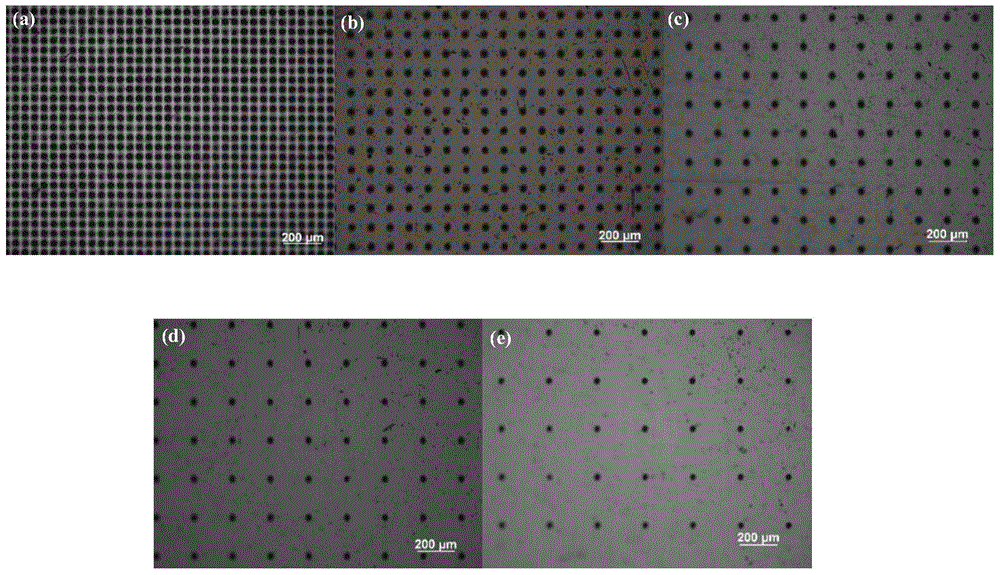Method for improving metal surface wettability by high energy beam texturing
A wettability and high-energy technology, applied in the field of metal surface treatment and surface treatment, can solve the problems of low connection strength, increasing the effective contact area between glass and metal, and poor wettability.
- Summary
- Abstract
- Description
- Claims
- Application Information
AI Technical Summary
Problems solved by technology
Method used
Image
Examples
Embodiment 1
[0050] The specific steps for improving the wettability of borosilicate glass on the Kovar surface by electron beam texturing are as follows:
[0051] (1) After smooth grinding the Kovar alloy plate with 200# to 1200# metallographic sandpaper in turn, ultrasonically clean it with acetone and alcohol solution, dry it and place it in a desiccator;
[0052] (2) Electron beam texturing: Kovar alloy is texturized by electron beam, and two textured morphologies of helical and hexagonal are obtained, such as figure 1 and figure 2 shown;
[0053] (3) In the atmospheric environment, the Kovar alloy sample was oxidized with a resistance furnace, and the composition was Fe. 3 O 4 and Fe 2 O 3 the oxide film;
[0054] (4) Heating the borosilicate glass to above the softening temperature, measuring the wetting angle of the borosilicate glass on the Kovar alloy surface, and the relationship between the wetting angle of the borosilicate glass on the Kovar alloy surface with different ...
Embodiment 2
[0056] (1) After smooth grinding the Kovar alloy plate with 200# to 1200# metallographic sandpaper in turn, ultrasonically clean it with acetone and alcohol solution, dry it and place it in a desiccator;
[0057] (2) Fiber laser texturing: PLY-20M SCANLAB 10 fiber laser was used to texturize Kovar alloy, and lattice textured morphologies with hole spacings of 0.3 mm, 0.4 mm, 0.5 mm, 0.6 mm and 0.7 mm were obtained. , the textured Kovar alloy is polished, and the textured appearance is as follows image 3 shown;
[0058] (3) In the atmospheric environment, the Kovar alloy sample was oxidized with a resistance furnace, and the composition was Fe. 3 O 4 and Fe 2 O 3 the oxide film;
[0059] (4) After heating the borosilicate glass from room temperature to 1000 °C for 20 min, and cooling it to room temperature with the furnace, the wetting angle of the borosilicate glass on the Kovar alloy surface was measured. The relationship between the wetting angle of the surface and th...
Embodiment 3
[0061] (1) After smooth grinding the Kovar alloy plate with 200# to 1200# metallographic sandpaper in turn, ultrasonically clean it with acetone and alcohol solution, dry it and place it in a desiccator;
[0062] (2) Femtosecond laser texturing: after polishing the Kovar alloy plate in step (1), the TC-22A type yttrium-doped fiber femtosecond laser is used to texturize the Kovar alloy to obtain a hole spacing of 0.05 mm, respectively. 0.10mm, 0.15mm, 0.20mm and 0.25mm lattice textured morphology, the textured Kovar alloy is polished, and the textured morphology is as follows Figure 4 shown;
[0063] (3) In the atmospheric environment, the Kovar alloy sample was oxidized with a resistance furnace, and the composition was Fe. 3 O 4 and Fe 2 O 3 the oxide film;
[0064] (4) After heating the borosilicate glass from room temperature to 1000 °C for 20 min, and cooling it to room temperature with the furnace, the wetting angle of the borosilicate glass on the Kovar alloy surfa...
PUM
 Login to View More
Login to View More Abstract
Description
Claims
Application Information
 Login to View More
Login to View More - R&D
- Intellectual Property
- Life Sciences
- Materials
- Tech Scout
- Unparalleled Data Quality
- Higher Quality Content
- 60% Fewer Hallucinations
Browse by: Latest US Patents, China's latest patents, Technical Efficacy Thesaurus, Application Domain, Technology Topic, Popular Technical Reports.
© 2025 PatSnap. All rights reserved.Legal|Privacy policy|Modern Slavery Act Transparency Statement|Sitemap|About US| Contact US: help@patsnap.com



